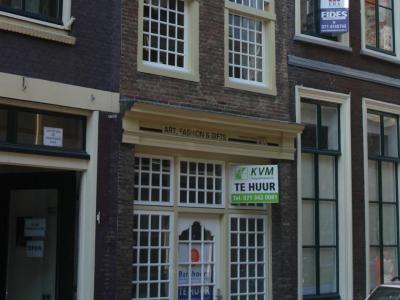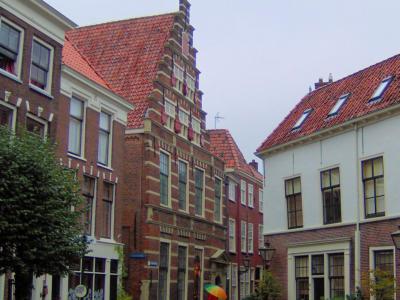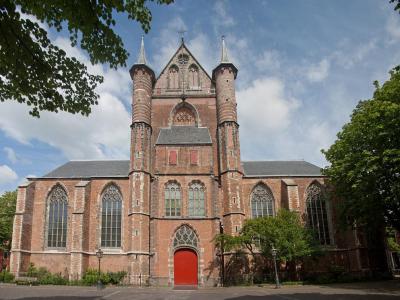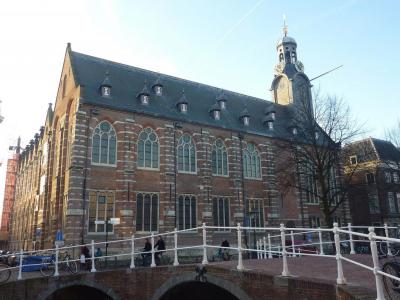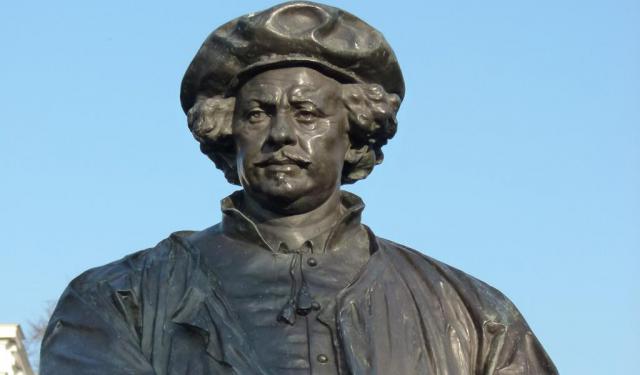
In the Footsteps of Young Rembrandt (Self Guided), Leiden
Once a thriving hub for trade and textile manufacturing, and a home to Holland's oldest university, Leiden also made history as the birthplace of Rembrandt van Rijn, one of the greatest visual artists of the mankind, renowned for his ingenious use of light and shadow, and life-like portraits. The Golden Age of the Netherlands can still be felt in Leiden, especially if you follow in the footsteps of young Rembrandt around the city.
You can start by visiting the workshop of Jacob van Swanenburgh who took the future master as an apprentice. In this 17th-century house, at Langebrug 89, Rembrandt learned how to draw, paint and make etchings.
Next, head to the Latin School on Lokhorststraat, where Rembrandt was educated, from 1616 to 1620, receiving preparatory training for university. It was here that he first learned to sketch at the hand of Henricus Rieverlinck, his art teacher.
After that, walk through Rembrandt's home neighbourhood of Pieterskwartier and visit Pieterskerk, the late-Gothic deconsecrated church featuring some stunning epitaphs, tombstones and artifacts.
The next stop is Leiden University, a 17th-century intellectual hub whose role in the Dutch Golden Age is hard to overestimate. Here Rembrandt was briefly enrolled.
Finally, a place where Rembrandt was born, in 1606. Although the original house is gone, it is still recognizable by a gable stone and a statue commemorating that.
There are many attractions and stories left from Rembrandt's Leiden. To hear some of them and to visit the historic locations associated with the famous master, embark on this self-guided walking tour and get a glimpse into the life of young Rembrandt.
You can start by visiting the workshop of Jacob van Swanenburgh who took the future master as an apprentice. In this 17th-century house, at Langebrug 89, Rembrandt learned how to draw, paint and make etchings.
Next, head to the Latin School on Lokhorststraat, where Rembrandt was educated, from 1616 to 1620, receiving preparatory training for university. It was here that he first learned to sketch at the hand of Henricus Rieverlinck, his art teacher.
After that, walk through Rembrandt's home neighbourhood of Pieterskwartier and visit Pieterskerk, the late-Gothic deconsecrated church featuring some stunning epitaphs, tombstones and artifacts.
The next stop is Leiden University, a 17th-century intellectual hub whose role in the Dutch Golden Age is hard to overestimate. Here Rembrandt was briefly enrolled.
Finally, a place where Rembrandt was born, in 1606. Although the original house is gone, it is still recognizable by a gable stone and a statue commemorating that.
There are many attractions and stories left from Rembrandt's Leiden. To hear some of them and to visit the historic locations associated with the famous master, embark on this self-guided walking tour and get a glimpse into the life of young Rembrandt.
How it works: Download the app "GPSmyCity: Walks in 1K+ Cities" from Apple App Store or Google Play Store to your mobile phone or tablet. The app turns your mobile device into a personal tour guide and its built-in GPS navigation functions guide you from one tour stop to next. The app works offline, so no data plan is needed when traveling abroad.
In the Footsteps of Young Rembrandt Map
Guide Name: In the Footsteps of Young Rembrandt
Guide Location: Netherlands » Leiden (See other walking tours in Leiden)
Guide Type: Self-guided Walking Tour (Sightseeing)
# of Attractions: 5
Tour Duration: 1 Hour(s)
Travel Distance: 1.2 Km or 0.7 Miles
Author: nicole
Sight(s) Featured in This Guide:
Guide Location: Netherlands » Leiden (See other walking tours in Leiden)
Guide Type: Self-guided Walking Tour (Sightseeing)
# of Attractions: 5
Tour Duration: 1 Hour(s)
Travel Distance: 1.2 Km or 0.7 Miles
Author: nicole
Sight(s) Featured in This Guide:
- Young Rembrandt Studio
- Latin School
- Pieterskerk (Saint Peter Church)
- Leiden University
- Rembrandt Birth House
1) Young Rembrandt Studio
The Young Rembrandt Studio is at Langebrug 89 in Leiden. It is a narrow three story brick building dating from the 17th century. Here is where Rembrandt spent his early years, studying under his mentor and teacher, Jacob van Swanenburgh.
In the Rembrandt Studio today one may view a seven minute film, in Dutch or English. The film uses "video mapping" to introduce one to the youthful Rembrandt and the important figures in his early life. It examines his unique talent, the materials he used and his methods of work. It covers the first 25 years of his life and career.
Swanenburgh was registered as a teacher of young Rembrandt in 1620. For three years Rembrandt studied with Swanenburgh in this house in Leiden. It is not clear what effect Swanenburgh's work may have had on Rembrandt. Rembrandt's interest in use of light, shadow and artificial lighting could have come from his teacher.
In the Rembrandt Studio today one may view a seven minute film, in Dutch or English. The film uses "video mapping" to introduce one to the youthful Rembrandt and the important figures in his early life. It examines his unique talent, the materials he used and his methods of work. It covers the first 25 years of his life and career.
Swanenburgh was registered as a teacher of young Rembrandt in 1620. For three years Rembrandt studied with Swanenburgh in this house in Leiden. It is not clear what effect Swanenburgh's work may have had on Rembrandt. Rembrandt's interest in use of light, shadow and artificial lighting could have come from his teacher.
2) Latin School
Latin schools were quite common throughout 17th-century Europe. Forerunners of today's grammar schools, they had classes taught solely in Latin. The aim was to provide preparatory courses for the university.
The Latin School in Leiden is a national monument, primarily due to the fact that among its students, at the time, was none other than Rembrandt van Rijn. Rembrandt attended the school from 1616 to 1620 and left without graduating. Whilst here he had learned to sketch, under Henricus Rieverlinck, his first art teacher.
A son of hard-working parents (his father was a miller, a middle-class profession in the 17th century), Rembrandt was their youngest child, for whom a career in art was not particularly envisaged. Luckily for us, though, Rembrandt did not choose a life of grinding grain, not even to make beer.
The Latin School building on Lokhorststraat dates from 1599-1600 and was designed in modern Renaissance style, with a high-rising stepped gable with widening on the right side. The entrance gate is in Tuscan style.
After the Latin School, the Stedelijk Gymnasium Leiden occupied the building until 1883, followed by other educational institutions after that. In 1982, the building was thoroughly restored and rented out to offices.
Presently, it is closed to visitors; however, you can still get your portrait sketched by Rembrandt van Rijn himself here. All you need to do is look in through the ground-floor window where you will see the brush strokes appear on the canvas, as if by magic. How cool is that! And if you had your sketch made, you can download it the following day.
The Latin School in Leiden is a national monument, primarily due to the fact that among its students, at the time, was none other than Rembrandt van Rijn. Rembrandt attended the school from 1616 to 1620 and left without graduating. Whilst here he had learned to sketch, under Henricus Rieverlinck, his first art teacher.
A son of hard-working parents (his father was a miller, a middle-class profession in the 17th century), Rembrandt was their youngest child, for whom a career in art was not particularly envisaged. Luckily for us, though, Rembrandt did not choose a life of grinding grain, not even to make beer.
The Latin School building on Lokhorststraat dates from 1599-1600 and was designed in modern Renaissance style, with a high-rising stepped gable with widening on the right side. The entrance gate is in Tuscan style.
After the Latin School, the Stedelijk Gymnasium Leiden occupied the building until 1883, followed by other educational institutions after that. In 1982, the building was thoroughly restored and rented out to offices.
Presently, it is closed to visitors; however, you can still get your portrait sketched by Rembrandt van Rijn himself here. All you need to do is look in through the ground-floor window where you will see the brush strokes appear on the canvas, as if by magic. How cool is that! And if you had your sketch made, you can download it the following day.
3) Pieterskerk (Saint Peter Church) (must see)
The Dutch word for "images storm" refers not to the weather, but to the inundations of violent iconoclasts that accompanied the Calvinist Reformation in the Netherlands in the 16th century. All Catholic art and images were stripped and looted from the churches. Stained glass windows were boarded up.
The pre-Reformation Saint Peter Church dated from about 1100 when the counts of Holland built a chapel on the site. The chapel was rebuilt in 1121. The current Church was completed in 1570, after 180 years of building. It opened for its first Protestant service in 1572.
Famed Dutch painter Rembrandt grew up and lived in the neighborhood of Saint Peter Church. His parents were married in the church in 1589. They are buried in front of the pulpit. Rembrandt frequented the church throughout his life. He was buried in Westerkerk in Amsterdam, in 1669.
In 1807 a devastating gunpowder explosion obliterated what was left of the stained glass windows. A major restoration was undertaken in 1880. The Saint Peter's Church was deconsecrated in 1971. With Government assistance, a long-term restoration was completed in 2010. Many artifacts, including a mummy, were unearthed.
John Robinson, the pastor of the "Pilgrim Fathers" of America, was buried in Saint Peter's Church. On October 3rd, each year, the people of Leiden offer thanks to God for saving the city in the Spanish siege of 1573. The proceedings are followed by eating herring and white bread with lots of beer.
The pre-Reformation Saint Peter Church dated from about 1100 when the counts of Holland built a chapel on the site. The chapel was rebuilt in 1121. The current Church was completed in 1570, after 180 years of building. It opened for its first Protestant service in 1572.
Famed Dutch painter Rembrandt grew up and lived in the neighborhood of Saint Peter Church. His parents were married in the church in 1589. They are buried in front of the pulpit. Rembrandt frequented the church throughout his life. He was buried in Westerkerk in Amsterdam, in 1669.
In 1807 a devastating gunpowder explosion obliterated what was left of the stained glass windows. A major restoration was undertaken in 1880. The Saint Peter's Church was deconsecrated in 1971. With Government assistance, a long-term restoration was completed in 2010. Many artifacts, including a mummy, were unearthed.
John Robinson, the pastor of the "Pilgrim Fathers" of America, was buried in Saint Peter's Church. On October 3rd, each year, the people of Leiden offer thanks to God for saving the city in the Spanish siege of 1573. The proceedings are followed by eating herring and white bread with lots of beer.
4) Leiden University
In May 1620, aged 14, Rembrandt Hermannzoon van Rijn enrolled at the University of Leiden. The University was relatively young back then, having been founded by William, Prince of Orange, in 1575. It started as a Protestant university and was presented as a reward to the city for its resistance to the Spanish during the Eighty Years' War.
Rembrandt did not seem to have attended classes here, as they were not mandatory in the past. Curiously, the enrolled students were also granted rations of tax-free beer, which was quite an incentive.
Another curious fact is the name of Philip II of Spain, as the count of Holland, on the university foundation certificate. Leiden University became renowned during the Dutch Golden Age. Its original location was the convent of Saint Barbara. It then moved, in 1577, to the Faliede Bagjin Church, and in 1581, to the convent of the White Nuns.
Today, the convent of the White Nuns houses the university museum. The university library has more than five million books, fifty thousand journals, and an extensive collection of Western and Asian manuscripts, books, prints, drawings, photos, maps, and charts.
The University does not have a central campus, but its buildings are spread over the city. As a student, Rembrandt often drew and painted university subjects. He drew inspiration from the famous university Botanical Gardens and the Anatomical Theatre, as shown in his later paintings, "Saskia as Flora" and "The Anatomy Lesson."
Rembrandt did not seem to have attended classes here, as they were not mandatory in the past. Curiously, the enrolled students were also granted rations of tax-free beer, which was quite an incentive.
Another curious fact is the name of Philip II of Spain, as the count of Holland, on the university foundation certificate. Leiden University became renowned during the Dutch Golden Age. Its original location was the convent of Saint Barbara. It then moved, in 1577, to the Faliede Bagjin Church, and in 1581, to the convent of the White Nuns.
Today, the convent of the White Nuns houses the university museum. The university library has more than five million books, fifty thousand journals, and an extensive collection of Western and Asian manuscripts, books, prints, drawings, photos, maps, and charts.
The University does not have a central campus, but its buildings are spread over the city. As a student, Rembrandt often drew and painted university subjects. He drew inspiration from the famous university Botanical Gardens and the Anatomical Theatre, as shown in his later paintings, "Saskia as Flora" and "The Anatomy Lesson."
5) Rembrandt Birth House
Rembrandt Harmenszoon van Rijn was born in Leiden in 1606. His father was Harmen Gerritszoon van Rijn, a miller. Neeltgen Willemsdochter, daughter of a baker, was his mother. Rembrandt was their eighth and last born child. There were actually ten children, but two died in infancy, a common occurrence in those days.
Stand on the Rembrandt Bridge. The Rhine River flows beneath your feet. The view from here includes a windmill like the one Rembrandt's father operated. To the east are the streets of Galgenwater (Gallow Waters). There was a gallows here and hangings were not infrequent.
Leave the bridge. Walk south. Enter the Weddesteeg. Proceed to number 27. Here was Rembrandt born. The house is gone. Well, there is a house here, but it's not the one our man was born in. That was demolished years ago. But wait. There's a plaque over the front door. It reads, "Here was born on the 15th of July 1606 REMBRANDT VAN RIJN."
That's all there is to see here. Walk west. You come to Rembrandt Park. This is the likely location of Windmill de Rijn, Rembrandt's father's establishment. It too, is gone. In time Rembrandt moved to Amsterdam. He was enormously successful but not wise with money. He died in penury. His birth house is gone, his grave unmarked.
Stand on the Rembrandt Bridge. The Rhine River flows beneath your feet. The view from here includes a windmill like the one Rembrandt's father operated. To the east are the streets of Galgenwater (Gallow Waters). There was a gallows here and hangings were not infrequent.
Leave the bridge. Walk south. Enter the Weddesteeg. Proceed to number 27. Here was Rembrandt born. The house is gone. Well, there is a house here, but it's not the one our man was born in. That was demolished years ago. But wait. There's a plaque over the front door. It reads, "Here was born on the 15th of July 1606 REMBRANDT VAN RIJN."
That's all there is to see here. Walk west. You come to Rembrandt Park. This is the likely location of Windmill de Rijn, Rembrandt's father's establishment. It too, is gone. In time Rembrandt moved to Amsterdam. He was enormously successful but not wise with money. He died in penury. His birth house is gone, his grave unmarked.
Walking Tours in Leiden, Netherlands
Create Your Own Walk in Leiden
Creating your own self-guided walk in Leiden is easy and fun. Choose the city attractions that you want to see and a walk route map will be created just for you. You can even set your hotel as the start point of the walk.
Leiden Introduction Walking Tour
In the year 860, at the confluence of the Old Rhine and the New Rhine, there was a settlement called "Leithon." This word referred to a canalized river. The name is appropriate. Leiden from its beginnings was a city of canals.
In 1060 Alewin I, landlord of Leiden, built his fortified keep, the "Burcht" ("Fort"). The village of Leiden huddled around the fortified... view more
Tour Duration: 1 Hour(s)
Travel Distance: 2.2 Km or 1.4 Miles
In 1060 Alewin I, landlord of Leiden, built his fortified keep, the "Burcht" ("Fort"). The village of Leiden huddled around the fortified... view more
Tour Duration: 1 Hour(s)
Travel Distance: 2.2 Km or 1.4 Miles
The Most Popular Cities
/ view all
